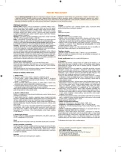Fetal magnetocardiography: A promising way to diagnose fetal arrhytmia and to study fetal heart rate variability?
Authors:
M. Hrtánková; K. Biringer; J. Siváková; P. Šumichrastová; P. Lukáč; J. Danko
Authors‘ workplace:
Gynekologicko-pôrodnícka klinika JLF UK a UNM, Martin, Slovenská republika, prednosta prof. MUDr. J. Danko, CSc.
Published in:
Ceska Gynekol 2015; 80(1): 58-63
Overview
Objective:
An overwiev of the new diagnostic method of fetal wellbeing – fetal magnetocardiography (fMCG).
Design:
A review article.
Setting:
Department of Gynecology and Obstetrics, Jessenius Faculty of Medicine in Martin, Comenius University in Bratislava, Slovak Republic.
Methods:
An analysis of the literature using database search engines PubMed, and SCOPE in field of fMCG.
Results:
Fetal magnetocardiography is a non-invasive technique able to monitor the spontaneous electrophy-siological activity of the fetal heart. Compared to cardiotocography and fetal electrocardiography, this is a more effective method with a higher resolution. The signal obtained from the fetal heart is sufficiently precise and the quality allows an assessment of PQRST complex alterations, and to detect fetal arrhythmia. Thanks to early diagnosis of fetal arrhythmia, there is the possibility for appropriate therapeutic intervention and the reduction of unexplained fetal death in late gestation. fMCG with high temporal resolution also increases the level of clinical trials which record fetal heart rate (FHR) variability. According to the latest theories, FHR variability is a possible indicator of fetal status and enables the study of the fetal autonomic nervous system indirectly. fMCG is an experimental method that requires expensive equipment. It is yet to be shown in the future, if this method will get any application in clinical practice..
Keywords:
fetal magnetocardiography, arrhythmia, fetal heart rate variability
Sources
1. Bernardes, J., Gonçalves, H., Ayres-de-Campos, D.,Rocha, AP. Linear and complex heart rate dynamics vary with sex in relation to fetal behavioural states. Early Hum Dev, 2008, 84(7), p. 433–439.
2. Cosmi, EV., Anceschi, MM., Cosmi, E., et al. Ultrasonographic patterns of fetal breathing movements in normal pregnancy. Int J Gynaecol Obstet, 2003, 80(3), p. 285–290.
3. Govindan, RB., Vairavan, S., Ulusar, UD., et al. A novel approach to track fetal movement using multi-sensor magnetocardiographic recordings. Ann Biomed Eng, 2011, 39(3), p. 964–972.
4. Hunter, JD., Sharma, P., Rathi, S. Long QT syndome. CEACCP, 2008, 8(2), p. 67–70.
5. Javorka, K., et al. Variabilita frekvencie srdca: Mechanizmy, hodnotenie, klinické využitie. Martin: Osveta, 2008, 204 s.
6. Kiefer-Schmidt, I., Lim, M., Wacker-Gussmann, A., et al.Fetal magnetocardiography (fMCG): moving forward in the establishment of clinical reference data by advanced biomagnetic instrumentation and analysis. J Perinat Med, 2012, 40(3), p. 277–286.
7. Lange, S., Van Leeuwen, P., Schneider, U., et al. Heart rate features in fetal behavioural states. Early Hum Dev, 2009, 85(2), p. 131–135.
8. Lutter, WJ., Wakai, RT. Indices and detectors for fetal MCG actography. IEEE Trans Biomed Eng, 2011, 58(6), p. 1874–1880.
9. Moraes, ER., Murta, LO., Baffa, O., et al. Linear and nonlinear measures of fetal heart rate patternsevaluated on very short fetal magnetocardiograms. Physiol meas, 2012, 33(10), p. 1563–1583.
10. Pillai, M., James, D. The development of fetal heart rate patterns during normal pregnancy. Obstet Gynecol, 1990, 76, p. 812–816.
11. Pumprla, J., Howorka, K., Groves, D., et al. Functional as-sessment of heart rate variability: physiological basis and practical applications. Int J Cardiol, 2002, 84(1), p. 1–14.
12. Schwartz, PJ., Stramba-Badiale, M., Segantini, A., et al. Prolongation of the QT interval and the sudden infant death syndrome. New Engl J Med, 1998, 338(24), p. 1709–1714.
13. Siira, SM., Ojala, TH., Vahlberg, TJ., et al. Marked fetal acidosis and specific changes in power spectrum analysis of fetal heart rate variability recorded during the last hour of labour. BJOG, 2005, 112 (4), p. 418–423.
14. Sonesson, SE. Diagnosing foetal atrioventricular heart blocks. Scand J Immunol, 2010, 72(3), p. 205–212.
15. Stinstra, JG. The reliability of the fetal magnetocardiogram. 2001. Dostupné na http://doc.utwente.nl/35964/1/t000001d.pdf 26.9.2013
16. Strasburger, JF., Cheulkar, B., Wakai, RT. Magneto-cardiography for fetal arrhythmias. Heart Rhythm, 2008, 5(7), p.1073–1076.
17. Strasburger, JF., Wakai, RT. Fetal cardiac arrhythmia detection and in utero therapy. Nat Rev Cardiol, 2010, 7(5), p. 277–290.
18. Trappe, HJ., Tchirikov, M. Cardiac arrhythmias in the pregnant woman and the fetus. Internist (Berl), 2008, 49(7), p. 788–798.
19. Van Leeuwen, P., Lange, S., Hackmann, J., et al. Assessment of intra-uterine growth retardation by fetal magnetocardio-graphy. 2001. Dostupné na http://citeseerx.ist.psu.edu/viewdoc/download?doi=10.1.1.9.8437&rep=rep1&type=pdf 26.9.2013
20. Van Leeuwen, P., Voss, A., Cysarz, D., et al. Automatic identification of fetal breathing movements in fetal RR interval time series. Comput Biol Med, 2012, 42(3), p. 342–346.
21. Wacker-Gussmann, A., Lim, M., Henes, J., et al. A new method in fetal heart electrophysiology – fetal magnetocardiography. Z Geburtshilfe Neonatol, 2011, 215(3), p. 125–128.
22. Wacker-Gußmann, A., Paulsen, H., Kiefer-Schmidt, I.,et al. Atrioventricular conduction delay in fetuses exposed to Anti-SSA/Ro and Anti-SSB/La antibodies: A magnetocardiography study. Clin Dev Immunol, 2012, 2012, 432176.
23. Wacker-Gußmann, A., Brändle, J., Weiss, M., et al. The effect of routine magnesium supplementation on fetal cardiac time intervals: a fetal magnetocardiographic study. Eur J Obstet Gynecol Reprod Biol, 2013, 168(2), p. 151–154.
24. Williams, KP., Galerneau, F. Intrapartum fetal heart rate patterns in the prediction of neonatal acidemia. Am J Obstet Gynecol, 2003, 188(3), p. 820–823.
Labels
Paediatric gynaecology Gynaecology and obstetrics Reproduction medicineArticle was published in
Czech Gynaecology

2015 Issue 1
Most read in this issue
- The 4G/4G polymorphism of the plasminogen activator inhibitor-1 (PAI-1) gene as an independent risk factor for placental insufficiency, which triggers fetal hemodynamic centralization
- Anterior colporrhaphy under local anesthesia
- The risk factors for pelvic floor trauma following vaginal delivery
- Transurethral Injection of Polyacrylamide Hydrogel (Bulkamid®) for the Treatment of Recurrent Stress Urinary Incontinence after Failed Tape Surgery
